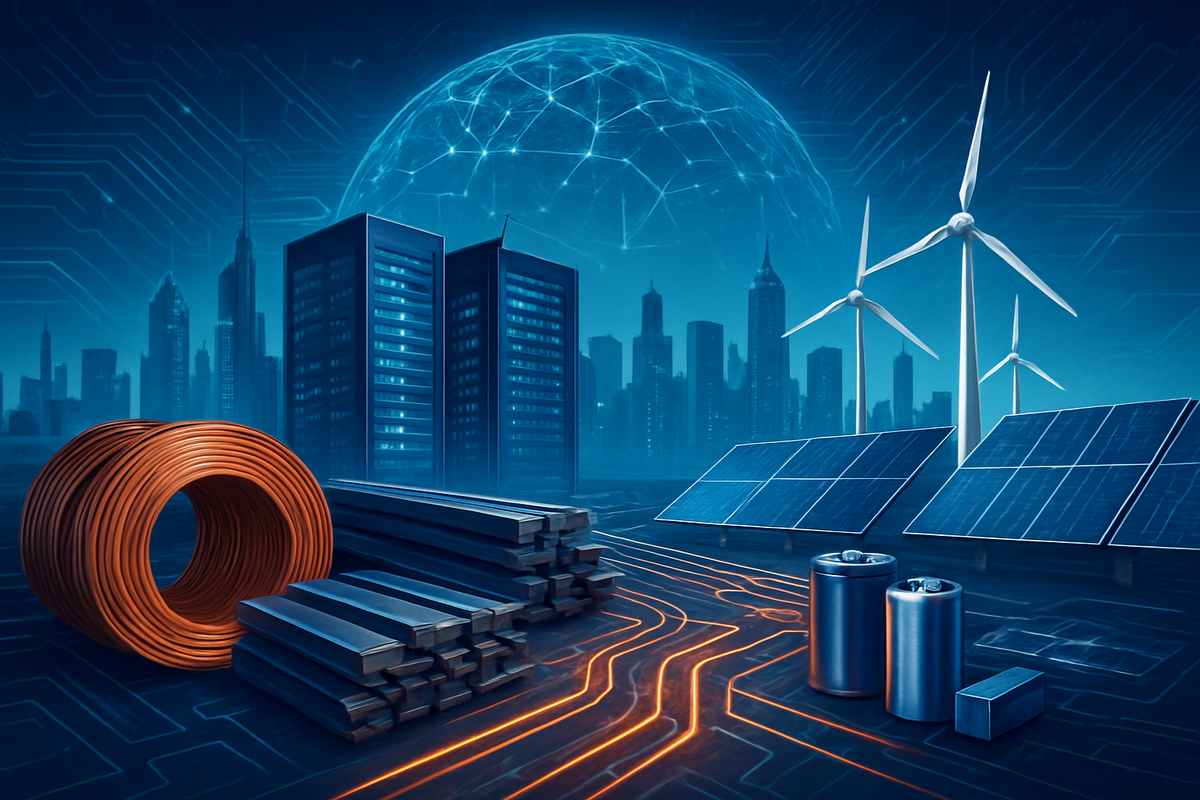
The glittering stages of global technology summits, such as the recent Web Summit Lisbon (November 2024) and the inaugural Web Summit Qatar (February 2025), might seem far removed from the gritty realities of commodity markets. Yet, beneath the buzz of AI breakthroughs and startup pitches, these influential gatherings are laying the groundwork for profound shifts in the demand and supply chains of critical raw materials. Through discussions on massive infrastructure projects, the relentless advance of Artificial Intelligence, and an unwavering commitment to sustainable energy, these summits are indirectly, yet powerfully, dictating the future trajectory of everything from copper and lithium to natural gas and steel. As of November 11, 2025, the ripple effects from these past events are becoming increasingly apparent, signaling a new era where technological innovation directly fuels commodity market dynamics.
These summits serve as pivotal forums where policymakers, industry titans, and investors converge to chart the course of global technology. The outcomes are not just new software features or investment rounds; they are strategic decisions that cascade through the global economy. The pronounced focus on building robust digital infrastructure, particularly state-of-the-art AI data centers, is creating an insatiable appetite for specific commodities. Simultaneously, the accelerating push for green energy solutions to power these digital behemoths is intensifying the demand for a distinct set of "transition minerals." This intricate dance between bits and bricks is setting the stage for significant reconfigurations in global trade and investment, making these tech-centric events crucial barometers for the broader financial markets.
From Code to Copper: Detailed Coverage of Summit Outcomes
The Web Summit Lisbon 2024 and Web Summit Qatar 2025 were dominated by themes that, upon closer inspection, have direct implications for commodity markets. At Web Summit Lisbon, a landmark announcement saw Microsoft (NASDAQ: MSFT) commit over $10 billion to build an AI data center hub in Sines, Portugal. This massive undertaking, in partnership with Start Campus and British AI infrastructure company Nscale, will house 12,600 next-generation NVIDIA (NASDAQ: NVDA) GPUs, aiming to establish Portugal as a European hub for AI "gigafactories" with total projected investments exceeding 16 billion euros. Such an enormous infrastructure project immediately translates into a surge in demand for traditional construction materials like steel, cement, and aluminum, as well as specialized metals for the vast electrical wiring and cooling systems. The sheer energy demands of these AI data centers, estimated by the International Energy Agency (IEA) to reach 415 terawatt hours (TWh) globally by 2024, also signal increased demand for electricity generation, potentially impacting natural gas and even uranium markets.
Similarly, the inaugural Web Summit Qatar in February 2025 was a significant event for the Middle East, positioning Qatar as a technology and innovation hub. The summit highlighted Qatar's ambitious Digital Agenda 2030, which involves substantial government and private sector investments in AI, cloud computing, and digital infrastructure. The Qatar Investment Authority (QIA) pledged over $1 billion in venture capital funds, with investments in data and AI companies like Databricks. Discussions underscored the strategic importance of AI for operational efficiency across sectors, from energy to healthcare. This regional push for digital transformation, mirroring global trends, will drive demand for high-performance computing components, advanced electronics, and the raw materials underpinning them. The summit also featured a dedicated "Energy" track, exploring sustainable futures and advancements in solar, wind, and energy storage, further solidifying the link between technological aspirations and the demand for critical "green" commodities. The timeline leading up to these events has been characterized by a global acceleration in digital transformation and a pressing need for energy transition, making these summits crucial checkpoints for observing how these macro trends translate into tangible economic actions.
Corporate Fortunes Forged in the Digital Crucible
The outcomes and discussions at these global summits present clear winners and potential challenges for a diverse array of public companies across the technology, construction, energy, and raw materials sectors.
Technology Giants like Microsoft (NASDAQ: MSFT), Alphabet (NASDAQ: GOOGL, GOOG), and Amazon (NASDAQ: AMZN), through their cloud services (Azure, Google Cloud, AWS) and AI partnerships, are positioned for substantial gains. They provide the core AI models, development platforms, and the vast cloud infrastructure that businesses globally are increasingly adopting. Semiconductor manufacturers such as NVIDIA (NASDAQ: NVDA), Intel (NASDAQ: INTC), and AMD (NASDAQ: AMD) are paramount winners, as the explosion in AI data center investments directly translates to soaring demand for their high-performance GPUs, CPUs, and accelerators. Companies providing networking and storage solutions, like Cisco Systems (NASDAQ: CSCO), Dell Technologies (NYSE: DELL), and Hewlett Packard Enterprise (NYSE: HPE), will also see increased sales from the build-out and upgrade of digital infrastructure.
Construction and Engineering Firms are direct beneficiaries of the physical manifestation of the digital boom. Giants such as AECOM (NYSE: ACM), involved in designing and building data centers, will secure significant contracts from the projected multi-trillion-dollar investments in AI infrastructure. Similarly, DigitalBridge (NYSE: DBRG), an asset manager focused on digital infrastructure like data centers and fiber networks, stands to gain from the expansion of connectivity essential for AI and IoT.
In the Energy Sector, the enormous energy appetite of AI data centers will significantly boost electricity consumption. Utility companies like Duke Energy (NYSE: DUK) and Constellation Energy Corp. (NASDAQ: CEG), already supplying power to data centers, will experience increased demand for electricity generation and transmission. Crucially, the push for sustainable data centers will accelerate demand for renewable energy, benefiting developers and equipment manufacturers like NextEra Energy (NYSE: NEE), Iberdrola (BME: IBE), and Vestas Wind Systems (CPH: VWS), as well as solar panel producers like Jinko Solar (NYSE: JKS) and Canadian Solar (NASDAQ: CSIQ).
Finally, the Raw Materials Sector is bracing for an "explosion" in demand. The rapid expansion of digital infrastructure and renewable energy technologies will drive an unprecedented need for various minerals. Copper, essential for wiring in data centers, grid expansion, and EVs, will see heightened demand. Battery metals such as lithium, nickel, cobalt, graphite, and manganese are crucial for energy storage and electric vehicles. Rare earth elements, vital for magnets in wind turbines and EV motors, will also experience significant growth. Companies involved in the mining and processing of these critical materials stand to gain substantially, though those unable to scale production or meet stringent ESG demands may face challenges.
Broader Currents: The Wider Significance
The discussions and outcomes at Web Summit Lisbon and Web Summit Qatar are not isolated events; they are powerful indicators and accelerators of several broader industry trends, with far-reaching implications for commodity markets. These summits underscore the relentless march of digitalization, particularly the pervasive integration of AI, IoT, and blockchain across all sectors. This trend is not just about new gadgets; it's about fundamentally reshaping supply chains, improving operational efficiency in mining and agriculture, and enhancing transparency in commodity trading. The real-time data analytics and predictive capabilities enabled by these technologies can optimize resource allocation and build resilience against disruptions, thereby influencing both demand and pricing stability for various commodities.
The AI boom, a central theme at both summits, is creating an unprecedented demand for computational power, necessitating the construction of colossal data centers. This directly translates into an escalating need for energy—primarily electricity—and a specific suite of raw materials, including copper for connectivity, silicon for semiconductors, and a range of specialized metals for advanced components. The energy footprint of AI is a growing concern, pushing for sustainable solutions and further intertwining the AI boom with the energy transition. This transition, vigorously debated at the summits, fundamentally alters commodity demand, shifting it away from fossil fuels towards "transition minerals" crucial for renewable energy generation (solar, wind) and storage (batteries for EVs and grid-scale solutions). An electric vehicle, for instance, requires six times more minerals than a conventional car, illustrating the scale of this shift.
These technological shifts create significant ripple effects on competitors and partners. New value chains are emerging, fostering collaborations between tech firms and traditional industrial players, such as AI analytics software companies partnering with agricultural or mining enterprises. Companies that fail to adapt to these technological advancements risk market disruption, while early adopters and technology providers stand to gain significant market share. Geopolitical tensions are also exacerbated by the race for critical raw materials, as nations vie for control over essential supply chains. Regulatory and policy implications are equally profound. Governments are grappling with data privacy, cybersecurity in interconnected industrial systems, and the ethical deployment of AI. Policies promoting sustainable sourcing and carbon reduction targets, such as the EU's Critical Raw Materials Act, are driving investment in domestic resource development and more transparent, environmentally responsible extraction practices. Historically, these periods of rapid technological advancement mirror past industrial revolutions, where innovations like mechanization or containerization fundamentally reshaped economies and commodity markets, leading to new demand patterns and production efficiencies.
The Road Ahead: What Comes Next
The trajectory set by global summits like Web Summit Lisbon and Web Summit Qatar points towards a dynamic and transformative future for commodity markets, with both short-term adjustments and long-term structural shifts.
In the short term, immediate investment announcements in AI and digital infrastructure are likely to cause localized spikes in demand for specific commodities. The rapid build-out of data centers will boost demand for industrial metals like copper, crucial for electrical grids and electronics, and construction materials like concrete and steel. This could introduce higher price volatility for these commodities if supply struggles to keep pace. Furthermore, the immense energy requirements of AI infrastructure may lead to short-term increases in demand for natural gas or even uranium for power generation, impacting their prices. Pilot programs and partnerships forged at these summits, focusing on digital tools for supply chain optimization or sustainable practices, could also create immediate, albeit smaller, demands for specific tech solutions and associated raw materials.
Looking at the long term, the impact becomes even more profound. The accelerating demand for critical minerals for the energy transition will continue unabated. Lithium, cobalt, nickel, manganese, and graphite, essential for batteries in EVs and renewable energy storage, will see sustained growth. The IEA forecasts a tripling of mineral demand from the clean energy sector by 2040. Simultaneously, the widespread adoption of AI, IoT, and data analytics across commodity production and processing will lead to significant efficiency and productivity gains. Precision farming, optimized mining operations, and streamlined logistics can stabilize supply, reduce waste, and potentially mitigate some price pressures. This also signals a long-term shift towards sustainable materials and a circular economy, increasing demand for recycled metals and reducing reliance on virgin raw materials. Companies must strategically pivot towards diversifying sourcing, investing in technology adoption, and integrating robust ESG practices into their operations. Market opportunities will emerge in "green commodities" and enhanced trading through AI, while challenges will include potential supply shortages, high investment costs for new technologies, and evolving ethical and regulatory concerns surrounding AI and sustainability.
Navigating the New Commodity Landscape: A Wrap-up
The Web Summit Lisbon and Web Summit Qatar, though primarily tech-focused, have delivered clear and compelling signals about the future of global commodity markets. The key takeaway is the profound and accelerating interdependence between technological innovation and raw material demand. The AI boom is not just about software; it's about the physical infrastructure—the data centers, the chips, the cooling systems—that require vast quantities of specialized metals and energy. Similarly, the urgent global commitment to the green energy transition, a recurring theme at these summits, is irrevocably tied to the supply of critical battery metals and industrial minerals. These are not fleeting trends but structural shifts that will redefine commodity value chains for decades.
Moving forward, the market appears to be at an inflection point, with strong structural tailwinds supporting commodity returns. Persistent inflationary pressures, a potentially weaker US dollar, and existing supply deficits across many physical commodity markets are all contributing factors. Geopolitical shifts, de-dollarization efforts, and stricter enforcement of sanctions will further influence supply routes and pricing. The convergence of AI-driven demand for computing power and the energy transition's hunger for critical minerals promises a robust demand-side outlook.
For investors, the coming months will require a nuanced understanding of these indirect connections. Watch for:
- AI and Data Center Commodity Demand: Monitor investment cycles in AI and data center infrastructure, as this will directly influence demand for precious metals (platinum group metals, gold, silver, palladium for components and circuitry) and could significantly boost natural gas consumption for power generation.
- Green Energy Transition Materials: Closely track the supply-demand balance of battery metals (lithium, cobalt, nickel, graphite) and industrial metals like copper. Geopolitical stability and investment in new mining capacity will be crucial.
- Supply Chain Innovation: Observe developments in blockchain, IoT, and other digital technologies applied to commodity supply chains, as these can lead to greater market transparency, reduced risk, and potentially more stable pricing.
- Macroeconomic and Geopolitical Factors: Remain vigilant on global inflation, central bank policies, the US dollar's strength, and geopolitical events that can disrupt supply or influence demand.
- Capital Expenditure in Natural Resources: Look for signs of increased investment in mining and natural resource production, as addressing existing supply deficits is paramount to meeting future demand.
The insights gleaned from these influential global summits highlight a future where technological evolution and commodity markets are inextricably linked. Investors who grasp these indirect connections and strategically position themselves will be better equipped to navigate the evolving and increasingly dynamic landscape of global commodities.
This content is intended for informational purposes only and is not financial advice





